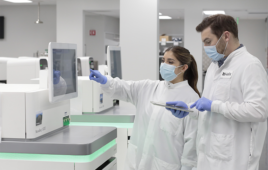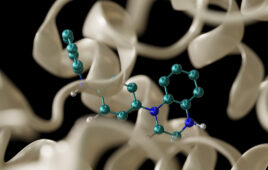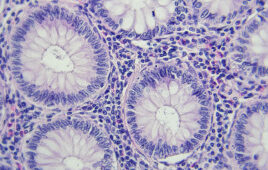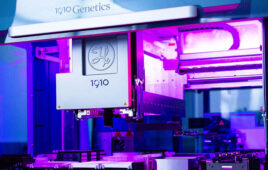As mapping protein interactions fast becomes the art and science of cutting-edge proteomics, new molecular tools emerge to aid the biological cartography.
Interactions between proteins are the foundations upon which many of the processes of nature are built. A touch between two proteins, coming together like dancers, initiates a cascade of other protein interactions, turning processes on and off, sending signals into or between cells, regulating the production of other proteins. And as with dancers, the interaction between a single pair may be easy to track with the eye, but it becomes impossible when two dancers are joined by a cast of thousands.
Mapping out this intricate choreography has become a central pursuit in proteomics. Although the study of protein interaction networks is still in its infancy, a number of prominent scientists have devoted their careers to the study of these networks, in the hope that, by understanding them, key information about biological mechanisms may be revealed.
For this type of research, the stakes are high, and so are the costs. Grant requests run into the millions of dollars, driven by the need for expensive screening equipment such as mass spectrometers and high throughput microarray setups. There is some question among scientists in the field as to whether it’s wise to invest so much in such a speculative science.
Is it worth it, yet?
Steven Wiley, PhD, is a lead scientist for biology in the Environmental Molecular Science Laboratory (EMSL) at Pacific National Laboratory in Richland, Wash. In addition to heading up the Biomolecular Systems Initiative at EMSL, Wiley is a member of a study section that reviews grants for the NIH. Regarding the question of the value of interaction proteomics, he says, “One of the questions people always ask is, ‘Is it worth it, yet? Are we really getting the right information from these things?’ For me, being in the field, yes, it is. If you don’t invest in the technology, you’ll never get there. It’s really critical that you learn this information … the question is what’s the best way of doing it?”
Wiley’s work at EMSL focuses on the interactions of membrane proteins, using gentle methods to solubilize membranes and preserve protein complexes, then using multiple reaction monitoring (MRM) to analyze proteins in those complexes. One of their major projects centers on Rhodopseudomonas palustris (or Rpal for short), a photosynthetic bacterium that uses light to generate hydrogen. It is not known exactly how the organism does this, but a number of groups are invested in finding out. If scientists can figure out what Rpal is doing, they might be able to use a similar mechanism for generating hydrogen easily and cheaply as an alternative fuel.
The search for biomarkers
It was once thought that in order to find biomarkers for disease, one could simply compare blood protein profiles between a diseased sample and a normal sample—via some screening technology such as mass spectrometry. However, for many reasons this turns out not to be true. For one thing, there is no single screening platform that can handle the relative abundance of all proteins in blood and plasma (the functional distribution is generally thought to be about twelve orders of magnitude). A second problem with this approach is that the proteins just don’t seem to behave. There are thousands of proteins in plasma. And for most diseases, it is very difficult to find a single protein that has a clear differential between the diseased and normal state.
An alternate path in the case of cancer markers is to start with tumor tissue and look for proteins that are up-regulated in tumor tissues, and see whether they show up in the blood, and could be used as biomarkers some day. This is the approach used by Julian Watts, PhD, and his colleagues at the Institute for Systems Biology in Seattle, Wash. “Once you’re sequencing proteins and identifying proteins in these tissues,” says Watts, “That’s where we use protein interaction data.” By mining data from publicly available protein interaction databases, they identify candidate markers and analyze them using multiple reaction monitoring.
The interesting thing about using this type of data mining approach for finding screening candidates is that it is agnostic to the validity of original experiments establishing that interaction. For example, in a project focusing on breast cancer, Watts’ group will obtain human breast tissue sample, removed surgically from cancer patient volunteers who are undergoing treatment. Comparison with normal breast tissue identifies proteins that are expressed only in the tumor tissue. So far, this is similar to the classical biomarker search. However, after obtaining this list of active proteins in breast tumor tissue, the next step is to look for functional relationships among them, using a protein interaction network based on publicly available data such as HPRD (www.hprd.org).
The benefit of using this added systems approach is that up-regulated proteins in the tumor tissue may not be good biomarker candidates themselves (for whatever reason), but they may point to other proteins in their network that could be potential biomarkers, and, for various reasons, did not turn up on the screen. (Later, we’ll talk about why this might happen.)
Says Watts, “Unlike the old fashioned fishing experiment, we’ve got lots of information where we can infer which 2000 proteins are more interesting … we go through a process of trying to eliminate those that are meaningless, looking for biological evidence that it’s worth studying subsets of proteins in more detail.”
The universe of proteins
The technical challenges of large-scale screening and mapping of protein interaction databases have caused some to question whether other approaches might not be more effective, such as genomics, metabolomics, or transcriptomics. Others, such as Peter Uetz, PhD, of the Craig Venter Institute, Rockville, Md., have attacked the problem head-on. Uetz’s studies include the mapping of interactions in viruses and bacteria via yeast two-hybrid screening, as well as the development of automated screening methods, and a focus on certain individual protein domain interactions.
Uetz became interested in protein interaction networks years ago while studying mouse developmental biology. He was looking at one protein thought to be involved in limb development. Says Uetz, “I did look at protein interactions because it was not known what the formin protein was doing … However, my interaction data did give me important clues as to what the protein was doing. It took four years to find four interactions. I thought there must be more efficient ways to look for protein interactions. That’s how I got into high throughput screening.”
Uetz’s lab does not concern itself with protein function, only with building protein interaction networks for its target organisms. Functional studies are left to others, and they publish their interaction data online to facilitate this collaboration (viral interaction maps are online at https://itgmv1.fzk.de/www/itg/uetz/virus/index.html). However, there are some hurdles to overcome in creating complete interaction maps, even for the simplest organisms. Says Uetz, “We find only 20% to 25% of all interactions using the yeast two-hybrid system. If another lab does the same study, with different protocols … it will cause them to find different data. For larger genomes, such as the human genome, there are still not a lot of interactions that are reproduced in additional studies. This was really shocking for a lot of people but it turns out that really small methodological differences cause these differences in results.”
Protein interaction networks present a daunting level of complexity, and efforts to map immense interactomes may be premature, based on the technology available. But there is no question that the ultimate payoff from these early efforts will be tremendous. Well-characterized protein interaction networks could produce biomarkers for hundreds of human diseases. They could also elucidate mechanisms for many poorly understood biological processes, yielding dividends in many scientific and engineering disciplines.
About the Author
Catherine Shaffer is a freelance science writer specializing in biotechnology and related disciplines with a background in laboratory research in the pharmaceutical industry.
This article was published in Drug Discovery & Development magazine: Vol. 11, No. 8, August, 2008, pp. 22-25.
Filed Under: Genomics/Proteomics





